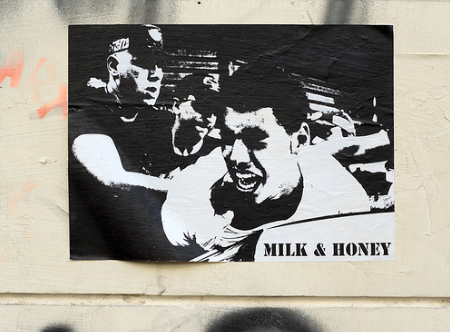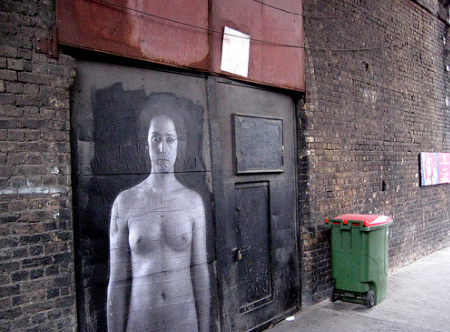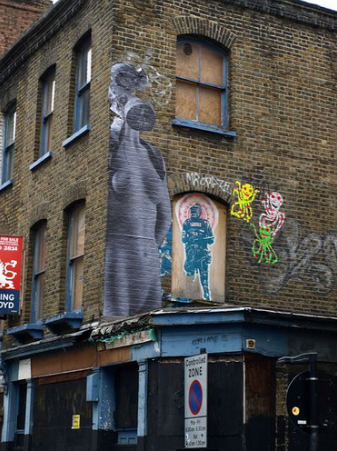Mike Marcus Interview

To start with. Who are you? Where are you from? And what do you do?
Mike Marcus: Mike Marcus, from London although I spent the best part of 7 years in the middle east which had a massive impact on my art. I am 3 things: a commercial artist working in film, a fine artist with a gallery career and a street artist. I am trying to move away from the first and merge the other two.
What got you into the street art scene?
Mike Marcus: I started actually with street interventions, not necessarily art. During the disengagement of Gaza. Israeli society was ideologically divided. Those who were against the disengagement put orange ribbons on their cars. As a response, the people who were pro-peace put blue ribbons on their cars. I went around swapping all the ribbons around and adding colors of my own. Around that time I was dating a brilliant artist and she started to spray these incredibly inspirational stencils around Tel Aviv. We started going out on missions together and I got hooked. There was a time when I thought that i might be allergic to spray paint so I got into pasteups and worked out the rules as I went.

How long have you been doing street art?
Mike Marcus: 4 or 5 years
Who or what influences you in your art?
Mike Marcus: I have a rich internal world. I spend much of my time upset or angry about what humanity achieves verses what it is capable of. I think a lot about my role as a fragment of society and think that others should similarly acknowledge that they have the power to make a better world if they just started caring. Much of my work talks about this in some way. In terms or inspirations from other artists, it changes constantly but currently I would list Yves Klien, Vanessa Beecroft, Vik Muniz and Anthony Gormley.
What’s the street art scene like in London?
Mike Marcus: Mostly crap! Everyone thinks it the centre of street art culture but it isn’t. Its just the centre of the “urban art” commerce scene. Obviously good work can be found on the streets but it has little to offer in comparison with the richness of New York or Tel Aviv.
You’ve done work in New York. How did you find the scene there? What was different from London?
Mike Marcus: I was surprised to find New York to be an incredibly creative place. I know that everyone always says that it is but I’m not one to fall for the romanticisation of American culture.
I was lucky enough to stay in Williamsbug which seems to be like the heart or NYC street art. The apartment where I was staying had a Dan Witz sticker in the hallway and a big Judith Supine pasteup across the road. I felt instantly at home there. I was totally inspired by artists who I had previously ignored. Revs is a great example. The quality of work seems to be more consistent than in London where half of Shoreditch is slapping up crap a stencil and releasing the print 5 days later.
I think though that while London has a bunch of people trying to make work which looks like Banksy, NYC has many Swoon copycats.
How do you want people to react when they see your art on the street?
Mike Marcus: I want them to be free to react in a way which suits them. I would be very complimented though if someone couldn’t quite grasp it. If they had understood the visual lexicon of street art and felt that my work didn’t fit what they were expecting to see.

You are famous for your mannequin in the gas mask. Is there a hidden story for this particular piece?
Mike Marcus: As much as there’s a hidden story in everything that everyone does yes. At the time of photographing the piece I was very aware that it was kind of a medley or a summing up of many of the themes that I had explored previously in my art. It wasn’t until much later that I actually wanted to analyse my direct psychological intention. This is a process which I am still continuing. I suffered guilt for a while each time I put one on the street because I felt that it was one of my less meaningful works. As the project progressed and they went up by their thousands, i started to realise that it was more a case that there were in fact a very rich, complex and elusive array of feelings inherrent in the image.
On shallower levels I was reasserting my presence in a city that I hadn’t lived in for a very long time. Under that was my way of expressing the anger and darkness which I brought back with me when I returned. Deeper still lies some primal stuff which I’m a little scared to look at.
I saw a reality in Palestine which shouldn’t have occurred. I was unable to stop my people slaughtering another race it and the work is a memorial to that loss of hope.
How often are you putting your art in the streets?
Mike Marcus: It depends on what I am working on. My street work tends to be studio driven. I create something and it might end up on the street as only one of a few different incarnations. This has led people to accuse me of using the street to market my prints but that isn’t a correct analysis. I often work for months on a single image and when i consider it finished I might want it to be seen by the kind of people who stand in galleries contemplating stuff but also by a public who laughs at that sort of behaviour.
When do you find is the best time to be putting your art up?
Mike Marcus: Whenever I have had enough pints to feel confident ![]()
How do you decide on the location of where you place your art work?
Mike Marcus: Placement has become more important to me as my work becomes bigger in scale. I try to set out with a variety of posters which I can mix and match into different compositions. I walk around an area which I don’t know until i find a place that sings. Then I try to put together a piece that fits using the pieces which I have. That might mean putting pasteups at regular intervals along a street or multiple times on the same building. Sometimes I will have ambitions for a certain place and keep it in my head until I work out how I want to express it.

What’s the craziest thing you’ve seen or experienced while putting up your art?
Mike Marcus: I few times i have managed to convince people that I wasn’t doing exactly what i was actually doing. Once the police caught me in the process of brushing the work onto the wall and ended up apologising to me because from a distance it looked like i was doing graffiti. ![]()
What can we expect to see from you in the future?
Mike Marcus: You can expect me to test peoples ideas about what kind of art belongs on the street. Enough people are bringing street art to the gallery, I want to bring fine art to the street.
Any last words for the Senses Lost readers?
Mike Marcus: Come to London and buy me a beer ![]()
| More Interviews >> |








